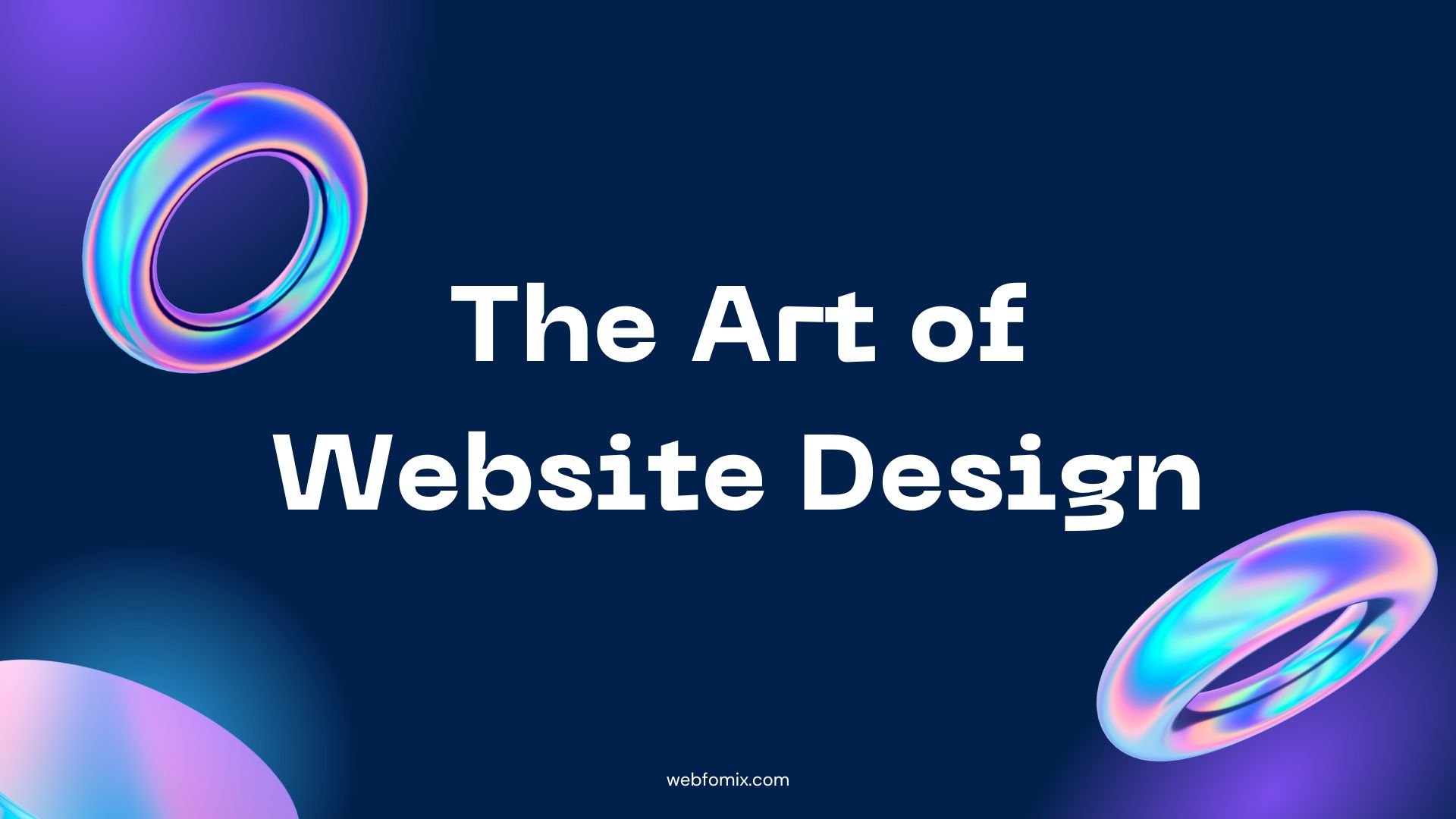In the fast-paced digital world, a well-designed website can make all the difference in captivating and retaining your audience. Welcome to an exploration of the art of website design, where we unlock the true power of user experience (UX). With a maximum of 160 words, this introduction sets the stage for an informative and engaging journey into the world of web design.
User experience, or UX, lies at the heart of effective web design. It combines visual appeal, functionality, and user-friendly interface to create a seamless browsing experience. From intuitive navigation and responsive design to compelling content and captivating visuals, successful websites are meticulously crafted to meet the needs and expectations of their users.
In this article, we delve into the elements that make up exceptional website design, providing you with insights and strategies to maximize user engagement and drive conversions. Whether you are a seasoned designer looking to enhance your skills or a business owner seeking to create an impactful online presence, this guide will equip you with the knowledge to unlock the potential of your website through the power of user experience.
Elements of effective website design
Website design plays a crucial role in the success of any online venture. A well-designed website not only enhances the visual appeal but also creates a positive user experience. With the ever-increasing competition in the digital landscape, users have become more discerning in their online interactions. They expect websites to be intuitive, engaging, and responsive. By investing in effective website design and user experience, businesses can gain a competitive edge and establish a strong online presence.
User experience encompasses various elements, including visual design, information architecture, usability, and accessibility. When these aspects are carefully integrated into the website design process, they enhance the overall user satisfaction and drive user engagement. A well-designed website not only attracts visitors but also encourages them to stay longer, explore further, and take desired actions, such as making a purchase or filling out a form.
To achieve exceptional website design and user experience, it is important to understand the needs, preferences, and behaviors of the target audience. By conducting thorough user research and employing user-centered design principles, designers can create websites that resonate with the target audience and fulfill their objectives. The ultimate goal is to provide a seamless browsing experience that is both visually appealing and intuitive, leading to increased user satisfaction and improved conversion rates.
The role of user experience in website design
Successful website design involves careful consideration of various elements that work together to create a cohesive and impactful online presence. These elements include:
1. Visual Design: The visual design of a website encompasses its overall aesthetics, including the layout, color scheme, typography, and imagery. A visually appealing website can capture the attention of users and convey the brand’s personality and values. It is important to strike a balance between creativity and usability to ensure a visually pleasing yet functional design.
2. Information Architecture: Information architecture refers to the organization and structure of the content on a website. It involves creating a logical hierarchy, intuitive navigation, and clear labeling to help users find the information they need easily. A well-designed information architecture enhances the user experience by reducing cognitive load and improving content discoverability.
3. Usability: Usability is a key aspect of website design that focuses on making the website easy to use and navigate. It involves optimizing the user interface, minimizing friction points, and ensuring that users can accomplish their goals efficiently. By providing a seamless and intuitive user experience, usability helps to build trust and encourage repeat visits.
4. Accessibility: Accessibility ensures that websites are usable and accessible to all users, including those with disabilities. It involves adhering to web accessibility standards and guidelines, such as providing alternative text for images, using appropriate color contrasts, and ensuring keyboard navigation. By designing for accessibility, websites can reach a wider audience and demonstrate inclusivity.
5. Responsive Design: With the increasing use of mobile devices, responsive design has become a necessity. Responsive design ensures that websites adapt and display correctly on different screen sizes and devices. By providing a consistent and optimized user experience across devices, responsive design improves user satisfaction and reduces bounce rates.
Key principles of user-centered design
User experience plays a critical role in website design as it focuses on meeting the expectations and needs of the users. When users visit a website, they have specific goals in mind, whether it’s finding information, making a purchase, or seeking entertainment. A well-designed user experience takes these goals into consideration and provides a seamless journey that guides users towards their desired outcomes.
The user experience encompasses the entire interaction users have with a website, from their first impression to their final action. It involves understanding user behavior, preferences, and motivations to create a design that is intuitive, engaging, and enjoyable. By prioritizing user experience, website designers can create websites that not only look great but also function effectively.
A positive user experience leads to various benefits for businesses, including increased user engagement, higher conversion rates, and improved customer satisfaction. When users have a positive experience on a website, they are more likely to stay longer, explore more pages, and take desired actions. This, in turn, can lead to higher conversion rates and increased revenue for businesses.
Understanding your target audience for better website design
User-centered design is a design approach that prioritizes the needs and preferences of the users throughout the design process. It involves understanding the target audience, conducting user research, and iterating on design solutions based on user feedback. By following key principles of user-centered design, designers can create websites that meet the needs of the users and provide a positive user experience.
1. Empathy: User-centered design starts with empathy for the users. Designers need to understand the users’ goals, challenges, and motivations to create a design that resonates with them. By putting themselves in the users’ shoes, designers can make informed design decisions that prioritize user needs.
2. User Research: User research plays a crucial role in understanding the target audience and their behaviors. It involves conducting surveys, interviews, and usability testing to gather insights about user preferences and pain points. By incorporating user research into the design process, designers can make informed decisions and create designs that address user needs.
3. Iterative Design: Iterative design involves continuously refining and improving the design based on user feedback. It allows designers to test and validate design decisions, make necessary adjustments, and ensure that the final design meets user expectations. By embracing an iterative approach, designers can create designs that are tailored to the users’ needs and preferences.
4. Usability Testing: Usability testing involves observing users as they interact with a prototype or a live website. It helps identify usability issues, uncover user preferences, and validate design decisions. By conducting usability testing, designers can gain valuable insights and make data-driven design decisions.
5. Consistency: Consistency is key in user-centered design. By using consistent design patterns, navigation structures, and visual cues, designers can create a sense of familiarity and make the website easier to navigate. Consistency also helps establish a strong brand identity and reinforces user trust.
By following these key principles, designers can create user-centered designs that prioritize user needs and provide a seamless browsing experience.
Planning your website design project
Understanding the target audience is essential for creating a website that resonates with users and meets their expectations. By gaining insights into their demographics, preferences, behaviors, and goals, designers can tailor the website design to their specific needs. Here are some strategies to help you understand your target audience better:
1. Conduct User Surveys: User surveys are a great way to gather information about your target audience. By asking targeted questions, you can gain insights into their preferences, pain points, and expectations. Surveys can be conducted through online tools or email campaigns, and the data collected can be used to inform the design decisions.
2. Analyze Website Analytics: Website analytics provide valuable data about user behavior, including the pages they visit, the time spent on each page, and the actions they take. By analyzing this data, designers can gain insights into user preferences and identify areas for improvement.
3. Create User Personas: User personas are fictional representations of your target audience based on research and data. They help designers understand the motivations, goals, and behaviors of different user segments. By creating user personas, designers can tailor the website design to meet the specific needs of each persona.
4. Conduct User Interviews: User interviews involve talking to users directly to gain insights into their needs, preferences, and pain points. By conducting one-on-one interviews, designers can gather qualitative data that helps them understand user motivations and expectations.
5. Analyze Competitor Websites: Analyzing competitor websites can provide valuable insights into user expectations and industry standards. By studying successful websites in your industry, designers can identify design patterns, features, and functionalities that resonate with users.
By understanding your target audience, you can create a website design that meets their needs and provides a positive user experience.
Best practices for designing a user-friendly website
Planning is a crucial step in the website design process as it sets the foundation for a successful project. By carefully planning your website design project, you can ensure that the design meets the objectives, stays within budget, and is delivered on time. Here are some key steps to consider when planning your website design project:
1. Define Project Goals and Objectives: Clearly define the goals and objectives of your website design project. What do you want to achieve with the website? Is it to increase brand awareness, generate leads, or drive sales? By setting clear goals, you can align the design decisions with the desired outcomes.
2. Conduct Competitive Analysis: Analyze competitor websites to understand the industry landscape, identify design trends, and discover opportunities for differentiation. By conducting a thorough competitive analysis, you can ensure that your website stands out from the competition.
3. Create a Project Timeline: Develop a project timeline that outlines the key milestones and deliverables. Break down the project into smaller tasks and assign timelines to each task. This will help keep the project on track and ensure timely delivery.
4. Determine the Budget: Determine the budget for your website design project. Consider factors such as design and development costs, hosting fees, and ongoing maintenance. By setting a realistic budget, you can ensure that the project stays within your financial constraints.
5. Collaborate with Stakeholders: Involve all relevant stakeholders in the planning process. This includes designers, developers, content creators, and other team members. By fostering collaboration, you can ensure that everyone is aligned with the project goals and objectives.
By carefully planning your website design project, you can set the stage for a successful design process and ensure that the final design meets your objectives.
Optimizing website navigation and usability
Designing a user-friendly website is essential for providing a positive user experience and driving user engagement. By following best practices for website design, you can create a website that is easy to use, visually appealing, and optimized for conversions. Here are some key best practices to consider:
1. Keep it Simple: Simplicity is key in website design. Avoid cluttered layouts, excessive text, and complicated navigation. Keep the design clean, with ample white space, and focus on the essential elements that guide users towards their goals.
2. Use Clear and Concise Language: Use clear and concise language to convey your message. Avoid jargon and technical terms that may confuse users. Use headings, subheadings, and bullet points to break up the text and make it easier to scan.
3. Optimize Page Load Speed: Page load speed is crucial for user experience. Optimize your website’s performance by minimizing file sizes, leveraging caching techniques, and using a content delivery network (CDN). A fast-loading website improves user satisfaction and reduces bounce rates.
4. Implement Responsive Design: Ensure that your website is responsive and adapts to different screen sizes and devices. Test your website on various devices to ensure a consistent and optimized user experience across platforms.
5. Use Intuitive Navigation: Design a clear and intuitive navigation structure that helps users find the information they need easily. Use descriptive labels, logical grouping, and visual cues to guide users through the website.
6. Incorporate Calls to Action: Use clear and compelling calls to action (CTAs) to encourage users to take desired actions. Make the CTAs prominent, with contrasting colors and persuasive copy.
7. Test and Iterate: Continuously test and iterate on your website design based on user feedback and data. Conduct usability testing, analyze website analytics, and gather user feedback to identify areas for improvement.
By following these best practices, you can create a user-friendly website that provides a seamless browsing experience and drives user engagement.
Incorporating visual elements in website design
Website navigation and usability are critical factors in providing a positive user experience. A well-designed navigation system and user-friendly interface ensure that users can find the information they need easily and accomplish their goals efficiently. Here are some strategies to optimize website navigation and usability:
1. Design Intuitive Navigation Menus: Design clear and intuitive navigation menus that guide users through the website. Use standard navigation patterns, such as a horizontal menu or a hamburger menu for mobile devices. Ensure that the navigation labels are descriptive and reflect the content of the pages.
2. Provide Search Functionality: Incorporate a search functionality that allows users to quickly find specific information. Place the search box prominently, preferably in the header or sidebar. Use autocomplete suggestions and advanced search filters to enhance the search experience.
3. Use Breadcrumbs: Breadcrumbs provide users with a clear path back to the homepage or parent pages. They help users understand their location within the website and navigate back to previous pages easily. Breadcrumbs also improve website accessibility and SEO.
4. Include a Site Map: A site map provides an overview of the website’s structure and content. It helps users understand the organization of the website and find specific pages quickly. Include a link to the site map in the footer or header for easy access.
5. Optimize Form Usability: If your website includes forms, optimize their usability by minimizing the number of fields, using clear labels and placeholders, and providing helpful error messages. Use validation techniques to ensure that users enter valid data.
6. Improve Mobile Navigation: Mobile navigation requires special attention due to the limited screen space. Use a responsive design that adapts to different screen sizes. Consider using a hamburger menu, collapsible menus, or sticky navigation to optimize mobile navigation.
7. Conduct Usability Testing: Usability testing involves observing users as they navigate the website and identifying any usability issues. Use tools like heatmaps, session recordings, and user testing platforms to gather insights into user behavior and identify areas for improvement.
By optimizing website navigation and usability, you can provide a seamless browsing experience that leads to increased user engagement and















